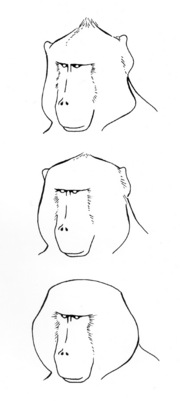Hybridity
 Heads of yellow (top), hybrid (middle) and anubis (bottom) baboons
Heads of yellow (top), hybrid (middle) and anubis (bottom) baboons
Long-term behavioral and genetic analyses of a wild primate population
Our goal is to develop a comprehensive picture of how behavior shapes population processes and fitness outcomes in the Amboseli baboons. Our conceptual framework is an integrative socioecology that is sensitive to the intrinsic interdependencies among behavior, physiology, genetic structure, and demography. Hence, our research addresses the fitness consequences of behavior as well as its physiological correlates and its population genetic consequences. Throughout our project, we focus on a series of short-term goals that represent components of their long-term objective. Specifically, we will follow the ongoing process of genetic admixture between a study population of primarily yellow baboons and neighboring populations of anubis (olive) baboons (a separate subspecies) in order to understand the way in which behavior impacts, and is in turn affected by this process. Our proposed work addresses new questions but is intimately connected to past and ongoing research on this population. Previous work has documented the nature and extent of this admixture as well as behavioral and life history differences of hybrids relative to yellows. This project represents a unique opportunity to follow a natural process of population admixture over time, and to test hypotheses about its behavioral causes and consequences.
